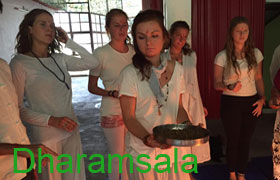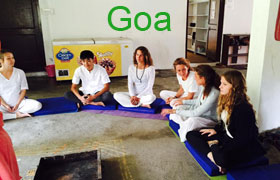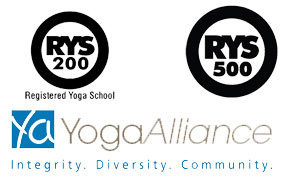Pranayama Rules
1. Pranayama should be practiced only after the practice of asanas. It should be done with empty stomach.
2. Pranayama can be practiced in padmasana or siddhasana or vajrasana or satvikasana. You should keep your spinal cord strictly straight during the practice of pranayama. Else you will not be able avail any of its benefits.
3. Prior to the practice of pranayama the yoga seeker should regulate the temperature of his body every day through the practice of kapalbhati.
4. You should try to concentrate on your nasal tip or on mooloadhara chakra or any other chakra during the practice of pranayama.
5. Poorak kriya should be practiced once with left nostril (idanadi) and once alternately with your right nostril (pidala nadi).
6. With the nostril other than with which you practice poorak kriya, you should practice rechak kriya. And with the same nostril you should now practice poorak kriya.
7. Followed by poorak kriya you should observe jalandhara bandha, moola bandha and uddiyana bandha in the mentioned order. Then you should practice kumbhak. In order to end the process of kumbhak and to practice rechak, you should start by releasing uddiyana bandha followed by moola bandha and jalandhara bandha in order.
8. You should perform poorak kriya followed by kumbhak with ida nadi. Following that you should practice rechak and kumbhak with pidala nadi. Then you should finish off with rechak with ida nadi. This will constitute one cycle of pranayama.
9. Initially you can start with doing 3 cycles of pranayama per day. Then you can increase by one cycle every four days and until 80 cycles per day. If you have to encounter with any interruption to your daily practice you should not increase the count of the cycles. You should try to continue your practice with stability. It your practice is interrupted for too many days, you must start with 3 cycles per day again.
10. For full practice, you should practice pranayama for four times in a day that is in the morning, mid-day, evening and mid night. If you are unable to do it for 4 times in a day, you should try to do at least twice that is in the morning and in the evening. If this also is not possible you should try to do it at least once in the morning. If you can practice this pranayama of 80 cycles four times a day for six months continuously, the seeker can succeed in awakening his kundalini. The affects that this practice has on the seekers physical body can be vividly noticed. However effects such as kundalini awakening may not be that clearly noticed as the progress of the pranayama is in general very slow.
11. You should strictly not eat or drink anything until half an hour after the practice of pranayama. You can eat or drink only after half an hour. Similarly you should not maintain at least four hours of gap after eating in order to practice paramayama. Practicing pranayama without maintaining this lapse may call for other consequences.
12. The yoga seeker practicing pranayama twice (morning and evening) a day or four times (morning, mid-day, evening and mid night) should invariably practice celibacy in strict order. Else the seeker may have to face consequences. People who practice pranayama once need not observe celibacy. However practice of celibacy will boost up the benefits that pranayama can impart.
13. The place selected for the practice of pranayama should be highly secluded, free from public intrusion and clutter-free. It should be safe, secure, and free from insects like mosquitoes and bedbugs and should not be windy. However it should be endowed with fresh air and should be free of dust and dirt. You can add the calming fragrance of guggle dhup to it.
14. Having idol or picture of the deity you worship in your vicinity proves to be helpful. You can perform all the rituals and puja before starting the practice. This will prepare the environment needed for the pranayama practice and also enables the yoga seeker to achieve success faster.
15. You should finish off with your defecation process and cleansing before you begin the pranayama practice. Taking a bath particularly in winter is not a prerequisite for the practice of pranayama. In fact taking a bath early in the morning is prohibited as per the rules of yoga. It is because in order to start the practice of pranayama, the temperature of the seekers body should be as per the predefined value. Thus taking a bath in winter early in the morning will naturally reduce the temperature of the body. It is dropped to even more extent if you take bath with cold water. This will eventually affect the practice of pranayama.
16. A seeker who is continuously immersed in the practice need not be bothered about seasons or months.
17. The person who practices pranayama should follow strict diet rules. He should live on milk, vegtables and fruits. Apart from these he can have kichidi particularly cooked with moong dal and ghee. Spicy foods should be avoided. The usage of mustard seeds or oil, sour, pepper, spices, tea, coffee and salt should be strictly prohibited by the yoga seeker who wishes to practice pranayama. However one who practices pranayama only once need not sacrifice all these.
18. You should keep your spinal cord straight during the practice of pranayama. Also, you should leave your eyes, nose and face naturally without imposing any kind of stress on them.
19. Rushing or skipping to follow any of the aforementioned rules during the practice of pranayama proves to be very harmful. Therefore the seeker should precariously follow all the rules without fail. Our yoga teacher training program in Goa particularly concentrates on each trainee to see that you strictly adhere to these rules in the training period.
यथा सिंहो गजो व्याघ्रो भवेत् वषयः शनैः शनिः |
तथैव सेवितो वायुः अन्यथा हन्ति साधकम || (हठयोग प्रदीपिका)
It means that pranayama is similar to the animals like lion, elephant, tiger etc. These animals need to be tamed gradually; else dealing with them might become dangerous to one’s life. Thus pranayama also should be practiced slowly; else you may have to face unnecessary complications. The cleansing of the nerves starts as soon as the practice of pranayama begins. Therefore various diseases dwelling in the body of the seeker will start to perish along with their root causes. The stagnation or degradation of the body will be alleviated. The body becomes stable. It will be endowed with brilliance and brightness which keeps growing day by day but never fades. The seeker’s capability to digest rises to such a level that he will be able to digest poison too. Unique beauty will be visible in the body of the seeker.
The human body consists of 72000 nadis, of which 3 of them are most important. They are ida nadi, pingala nadi and shushumna nadi. Ida nadi is also called chandra nadi which flows through the left nostril. On the other hand the nerve that flows through the right nostril is called surya nadi or pingala nadi. Chandra nadi displays the features of moon, thus it is found to be gentle and smooth while the surya nadi is found to be hot due to respiration. There are 10 kinds of vayu (air / gas) which are involved in the natural metabolism of the human body. Out of these 5 of them are fall under the category of “prana” while the remaining 5 falls under the category of “upaprana”. They are prana, apana, vyana, udaana, saman, naag, kurma, kukal, devdatta and dhanaunjay. The first five are the prana vayus while the remaining are the upaprana vayus.




